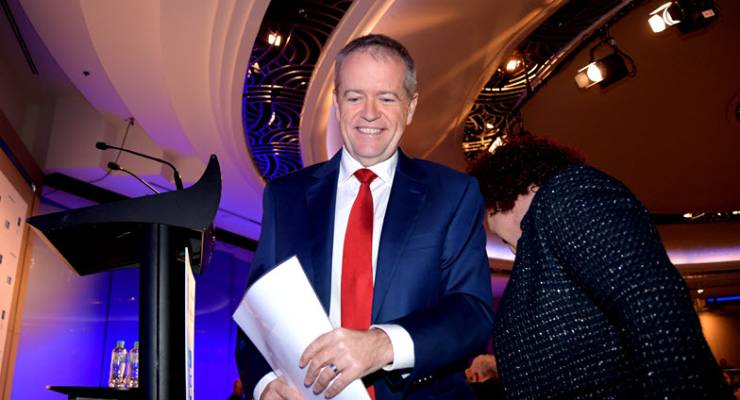
Rising inequality, says the Leader of the Opposition, is a terrible fact of Australian life. Rising inequality, says the Treasurer, is a non-fact that opposition leaders evoke when what they really want to do is stunt economic growth. The Herald Sun says that everyone should just shut up about rising inequality, because causing people to worry about what they don’t have and can’t get is a destructive “politics of envy”. There’s no point in scrutinising the odd claims of the Herald Sun — it’d be a bit like arguing with my Aunty Dot about global warming three sherries in. But there must be a point in scrutinising what is meant by “inequality” and how much of it we have, or don’t have, in this nation.
The ALP has been making soft noises about inequality for a couple of years. In 2015, Bill Shorten declared on Q&A that Australian inequality was at a 75-year high. The source for this statistic was research by shadow assistant treasurer and former economics professor Andrew Leigh, as, presumably, it was last Friday when Shorten made a widely reported speech at the Melbourne Institute. On this occasion, observers say, the politician had Corbyn-ed up a shred, and called the fight against inequality the “defining mission” of his party. Heck. The guy even made a joke about Adam Smith’s “invisible hand”.
All this from a chap who was once, perhaps not unreasonably, warned by a colleague against the temptation of becoming one of “Paul and Bob’s dumb step-kids“. Even as recently as May, when Paul Keating himself warned against Keating-era economic nostalgia, Shorten seemed shy of proposing new reform to meet capitalism’s newer crises. Maybe he is genuinely prepared to adapt to what he sees as genuine inequality. Maybe he just borrowed some of Corbyn’s successful speech. Either way, after Friday, the inequality conversation is now being heard by Australians other than those who subscribe to podcasts tagged with “Thomas Piketty”, but it’s not an easy one to understand.
[The surprisingly quick death of neoliberalism in Australia is underway]
Not many claims about inequality, either global or domestic, are easy to understand. And that’s not just me, the macroeconomics dummy, making this claim, but recipient of the Nobel Memorial Prize in Economic Sciences, Joseph Stiglitz. This former chief economist at the World Bank says that a good deal of World Bank data is bunkum. Those guys, with their private sector partnerships, say that their lending to liberal economies has lifted millions out of poverty. The real lifter, however, was China, which can accept no World Bank loan and has never had any truck with the neoliberal consensus. Which is to say that you can’t always trust the policymakers to write an honest “inequality” report card for themselves.
Still. Belief in the benefits of market-friendly policies is largely upheld by Western leaders, and at the same Melbourne Institute event at which Shorten spoke, Malcolm Turnbull offered his defence of the power of “free” trade. After Shorten’s speech, Scott Morrison came at him with another graph, the Gini coefficient, an index of global inequality. You can easily find reputable accounts of why the Gini, a relative and not an absolute measure, is also bunkum, or you can read this brief account I tore from Joanthon Louth, Research Fellow at Flinders Uni in the College of Business, Government and Law.
“The Gini coefficient is used as a relative measure — so if there is a percentage increase for somebody who is poor, say 10% and somebody who is very rich has a percentage increase of 5% then inequality has been reduced. Of course, the very poor person may only earn $1000 a year; with the increase, they would now have an income of $1100. The very rich individual may have an income of $500,000; with the 5% increase they now have an additional $24,000. But, hey, we’ve reduced inequality!”
Inequality can’t always be seen in the elegant curve of the relative Gini. Inequality, according to Roger Wilkins, a respected Australian centrist economist and deputy director of the Melbourne Institute, cannot be seen in the way that Bill Shorten says it can. Why? Well, says Jeff Borland, professor of economics at the University of Melbourne, when I ask him, “It’s like Definition City when you’re working on this stuff.”
[Rundle: how do you solve a problem like neoliberalism?]
There is no consensus on what reliably defines inequality. Borland’s work is around the labour market, and he says that there can be no argument that the income distribution in Australia has become more unequal over time, a problem that he says was partially overcome for a decade by the taxes and transfers of step-dads Bob and Paul. But, he notes, Wilkins uses different measures for inequality, including the HILDA Survey. Wilkins takes into account measures of household expenditure and — although I’m not quite following at this point — has some sort of problem with ABS income data collection methods, which, in his view, changed in the mid-2000s so as to corrupt and overly inflate the small percentage of high wage earners over time and … well, it’s like Definition City. Borland reckons it might be a good idea to get everyone working on metrics for inequality in a single room for a day. Then we can decide how unequal things are, or how much the “lifters” of neoliberalism have done for people taking out all those lovely new payday loans.
Frank Stilwell, USyd’s Emeritus Professor, known for many years for his heterodox proposals, confirms that there are many ways of measuring poverty or inequality, including that of half the median wage, an accepted OECD index that has recently been decried by Human Services Minister Alan Tudge. Stilwell does say that even by the most conventional measures, inequality has been increasing in Australia. He points to analysis by Peter Whiteford published in the last edition of Australian Quarterly. “His very sober and responsible summary of the data does indeed confirm rising inequality in relation to incomes.”
Stilwell is a political economist, a big-picture guy. Evidence of inequality is not exclusively about econometrics for such scholars, but evident forces in an economy. He urges us to consider “the scissors movement between labour market trends that are causing more people to have insecure and low incomes and housing market trends that are requiring people to have secure and rising incomes in order to have secure accommodation”. Which makes more sense to me than the relative Gini.
Associate professor Lynne Chester, also a political economist, says that we must consider inequality in a way that is “beyond metrics”. This, by the by, is not her call for a figure-free academic utopia wherein one can just call out inequality if one is so disposed. It is, rather, an admission that persons “are not atomised individuals who fill some sort of model based on econometrics” but subject to a range of cumulative inequality that can, and often does, include housing, education, wages, unmet energy costs and other factors that do not find their way into conventional academic textbooks.
Single numbers or data sets, she says, are the points, “where debates get masked and the political reality is ignored”. Solutions are not the preserve of one set of metrics or one sort of policy change, but must be found in a broader social and economic understanding.
The one thing everyone — even Morrison and Turnbull to a limited degree — can agree about is that Australian inequality is now at an economically, if not morally, undesirable level. If we are unable to arrive at a meaningful and workable consensus within “Definition City”, then we certainly can’t trust that invisible hand to fix things.








Yeah, definition city, where any reasonable argument against what are clearly neoliberal policies are then defended by diversions about definitions. Mind you, definitions would be fine if we could agree on them, but that ain’t gonna happen soon. It tends to benefit the ruling class to question definitions – “what do you mean by ‘my foot is on your throat’?”
From this piece and Bernard’s, I am reminded of the common theme from the capital class representing the biggest of corporates that they ‘require certainty’ to be able to invest/make money/bleed everyone dry.
While insisting on certainty, they offer low wages and casual employment, and policies that ensure high house prices and a rigged energy market. If large corporates had to operate with the levels of uncertainty of the average under 30, or less than median wage anybody, they would be squealing.
Saul Eslake on John Faine’s program this morning said Morrison would have had to have been in a darkened sound-proof room for the past 20 years to be unaware of increasing inequality in Oz. He also said that while our inequality is increasing, it is not increasing as quickly as in other countries such as USA. So in the Lucky Country we are all off to hell in a handbasket, just a bit more sedately. Thanks for the analysis Helen
Sounds like Hillsong to me.
It’s not only differences in wages and salaries that make us unequal.
Malcolm Turnbull’s $507,338 salary for being PM is dwarfed by the returns on his $200m investment portfolio (and I bet he gets a better return on his money than I do on mine).
The one percent’s wealth is not primarily made up of wages, but of returns on capital investments. This also has to be addressed to reduce inequality.
Inheritance taxes on large estates anyone?
This article was the perfect riposte to the preceding one by our, allegedly, recovering neolib nutter BK.
It is rare for MzRaz to write so sparely, “just the facts ma’am”, when one just knows she was busting to break out the adjectives.
Extremely well put, dispassionate enough not to frighten the horses whilst providing them with sufficient fodder to kick over the traces and run free.
This article was the perfect riposte to the preceding one by our, allegedly, recovering neolib nutter BK.
I’ve been wondering, since I don’t read Crikey every day – when did BK have his Damascus moment ? It’s happened sometime in the last six months or so.
You’ve been noticeable by your absence from the comments section dear Doc, I enjoy your contributions.
Bernie’s conversion is about a fortnight old I’d say. I’m not convinced he’s comfortable in his new skin though, old habits die hard.
As Helen Razer says, arcane debates over how to define inequality in measures and noting changes in ABS statistics are beside the point . The point is that we need to check our definitions against the reality of inequality, with one of the best discussions of that being by Kate Pickard and Richard Wilkinson, called “The Spirit Level: Why More Equal Societies Almost Always Do Better”.